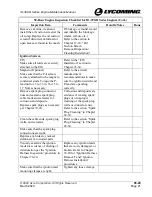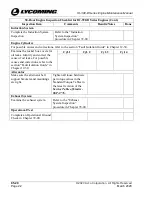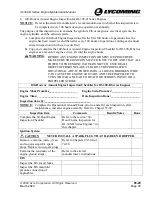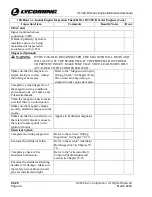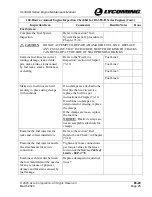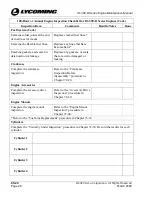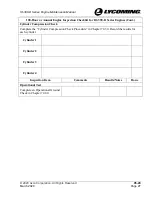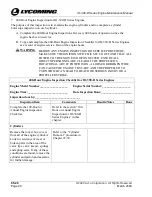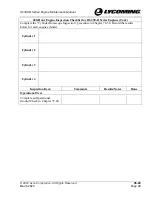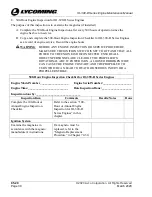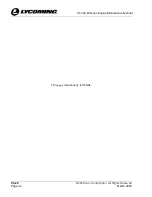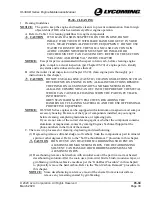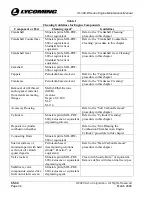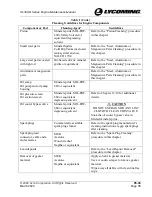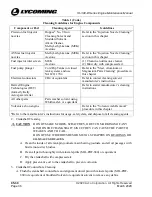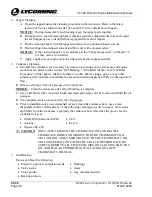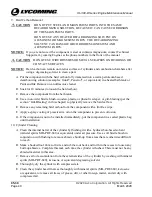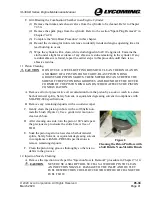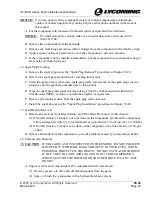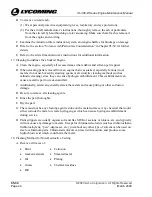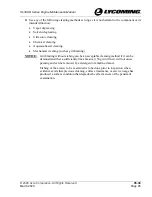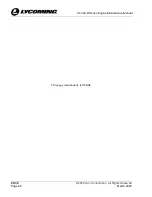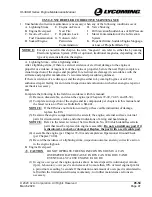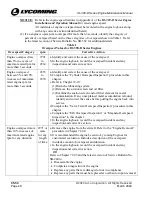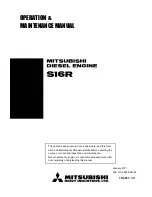
IO-390-D Series Engine Maintenance Manual
© 2020 Avco Corporation. All Rights Reserved
05-30
March 2020
Page 33
IO-390-D Series Engine Maintenance Manual
05-30 - CLEANING
1.
Cleaning Guidelines
NOTICE:
The goal to keep the engine and nacelle clean is to prevent contamination from foreign
object debris (FOD) which can adversely affect engine operation.
A.
Refer to Table 1 for cleaning guidelines for engine components.
CAUTION
IF VOLCANIC ASH IS SUSPECTED ON THE ENGINE, DO NOT
INHALE IT OR TOUCH IT WITH BARE HANDS OR GET IT IN YOUR
EYES. WEAR PERSONAL PROTECTIVE EQUIPMENT. DO NOT USE
WATER TO RINSE IT OFF. THE VOLCANIC ASH CAN CONTAIN
ACIDIC COMPOUNDS WHICH MUST NOT BE INHALED OR
TOUCHED SINCE IT CAN CAUSE INJURY. REFER TO THE SECTION
"VOLCANIC ASH REMOVAL" IN THIS CHAPTER.
NOTICE:
Except for parts contaminated with suspect volcanic ash, before cleaning engine
parts, complete a visual inspection (per Chapter 05-20) of engine parts to identify
any stains and residues and sources thereof.
B.
After the initial visual inspection (in Chapter 05-20), clean engine parts thoroughly per
instructions in this chapter.
CAUTION
DO NOT USE ALKALINE (CAUSTIC) CLEANING SOLUTIONS SUCH AS
DETERGENTS ON ENGINE PARTS. ALKALINE SOLUTIONS REMOVE
THE FINISH ON ALUMINUM PARTS AND MAGNESIUM PARTS.
ALKALINE COMPOUNDS CAN GET INTO THE PORES OF THE METAL
WHICH CAN CAUSE OIL FOAMING WHEN THE PART IS PUT BACK
INTO SERVICE.
OBEY STANDARD SAFETY PRACTICES REGARDING THE
HANDLING OF CLEANING MATERIALS AND THE USE OF PERSONAL
PROTECTIVE EQUIPMENT.
NOTICE:
IO-390-D Series engines can be equipped with aluminum or magnesium oil sump or
accessory housing. Be aware of the type of components installed on your engine
before cleaning, completing maintenance, or replacing parts.
If you are not sure of the correct cleaning agent or whether the component contains
aluminum or magnesium, contact Lycoming Engines Technical Support at the
phone numbers in the front of the manual.
C.
There are two processes for cleaning: degreasing and decarbonizing.
(1)
Degreasing removes dirt and sludge (soft carbon). Soak the component or part in mineral
spirits or other degreaser. Refer to the “Soft Carbon Removal” procedure in this chapter.
CAUTION
DO NOT USE ANY HEATED DECARBONIZING SOLVENT ON
ALUMINUM OR MAGNESIUM PARTS. THE DECARBONIZING
SOLVENT CAN DAMAGE OR CORRODE MAGNESIUM AND
ALUMINUM PARTS.
(2)
Decarbonzing removes hard carbon with an initial soak of the part in a warm or heated
decarbonizing solution. After the soak, use a (non-wire) bristle brush, wooden scraper, or
grit-blasting (with non-abrasive media as per the “Grit-Blast Procedure” in this chapter)
to physically remove the hard carbon. Refer to the “Hard Carbon Removal” procedure in
this chapter.
NOTICE:
Since decarbonizing can remove most of the enamel from exterior surfaces,
remove any remaining enamel by grit-blasting.



